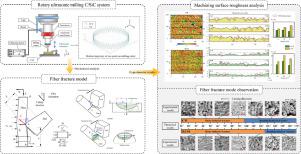当前位置:
X-MOL 学术
›
Int. J. Mech. Sci.
›
论文详情
Our official English website, www.x-mol.net, welcomes your feedback! (Note: you will need to create a separate account there.)
Investigation on fiber fracture mechanism of C/SiC composites by rotary ultrasonic milling
International Journal of Mechanical Sciences ( IF 7.3 ) Pub Date : 2021-02-01 , DOI: 10.1016/j.ijmecsci.2020.106054 Feng Xue , Kan Zheng , Wenhe Liao , Jing Shu , Song Dong
International Journal of Mechanical Sciences ( IF 7.3 ) Pub Date : 2021-02-01 , DOI: 10.1016/j.ijmecsci.2020.106054 Feng Xue , Kan Zheng , Wenhe Liao , Jing Shu , Song Dong

|
Abstract With wide application of continuous carbon fiber reinforced silicon carbide matrix (C/SiC) composites, machining damages have been paid more and more attention. Due to prominent anisotropy and heterogeneity, fiber damages affect the service performance of C/SiC parts directly. Surface quality is closely related to fiber fracture mechanism. This paper emphatically analyzed fiber removal process of rotary ultrasonic milling (RUM) of C/SiC composites. A calculation method for fiber fracture stress based on ultrasonic vibration was presented. High-frequency, low-amplitude oscillation varied fiber cutting angle and increased fiber shear stress through deflecting friction form the axial section to radial section of fiber. It promoted shear fracture mode to dominant removal mechanism greatly. The proportion of fiber cutting angle under shear fracture mode was enlarged by 30%. Then both RUM and conventional milling (CM) C/SiC tests were carried out. The principle of surface quality improvement during rotating ultrasonic milling was presented. Experimental results showed that fiber cutting angle affected C/SiC surface morphology directly. Surface of RUM had better machining quality with less delamination, fiber-matrix debonding length and fiber pulling-out damage. Its surface roughness Sa values were reduced by 26.8% and 40.6% during fiber forward cutting and backward cutting, respectively. It proved the rationality and effectiveness of rotary ultrasonic milling C/SiC composites.
中文翻译:

C/SiC复合材料旋转超声铣削纤维断裂机理研究
摘要 随着连续碳纤维增强碳化硅基(C/SiC)复合材料的广泛应用,加工损伤越来越受到重视。由于显着的各向异性和非均质性,纤维损伤直接影响 C/SiC 零件的使用性能。表面质量与纤维断裂机理密切相关。本文重点分析了C/SiC复合材料旋转超声铣削(RUM)的纤维去除过程。提出了一种基于超声振动的纤维断裂应力计算方法。高频、低振幅振荡改变了纤维切割角度,并通过从纤维的轴向截面到径向截面的偏转摩擦来增加纤维剪切应力。它极大地促进了剪切断裂模式成为主导去除机制。剪切断裂模式下的纤维切割角比例扩大了30%。然后进行了 RUM 和常规铣削 (CM) C/SiC 测试。介绍了旋转超声铣削过程中提高表面质量的原理。实验结果表明,纤维切割角度直接影响C/SiC表面形貌。RUM 表面具有更好的加工质量,更少的分层、纤维-基体脱粘长度和纤维拉出损伤。在纤维前切和后切过程中,其表面粗糙度Sa值分别降低了26.8%和40.6%。证明了旋转超声铣削C/SiC复合材料的合理性和有效性。介绍了旋转超声铣削过程中提高表面质量的原理。实验结果表明,纤维切割角度直接影响C/SiC表面形貌。RUM 表面具有更好的加工质量,更少的分层、纤维-基体脱粘长度和纤维拉出损伤。在纤维前切和后切过程中,其表面粗糙度Sa值分别降低了26.8%和40.6%。证明了旋转超声铣削C/SiC复合材料的合理性和有效性。介绍了旋转超声铣削过程中提高表面质量的原理。实验结果表明,纤维切割角度直接影响C/SiC表面形貌。RUM 表面具有更好的加工质量,更少的分层、纤维-基体脱粘长度和纤维拉出损伤。在纤维前切和后切过程中,其表面粗糙度Sa值分别降低了26.8%和40.6%。证明了旋转超声铣削C/SiC复合材料的合理性和有效性。光纤正向切割和反向切割时分别为 8% 和 40.6%。证明了旋转超声铣削C/SiC复合材料的合理性和有效性。光纤正向切割和反向切割时分别为 8% 和 40.6%。证明了旋转超声铣削C/SiC复合材料的合理性和有效性。
更新日期:2021-02-01
中文翻译:

C/SiC复合材料旋转超声铣削纤维断裂机理研究
摘要 随着连续碳纤维增强碳化硅基(C/SiC)复合材料的广泛应用,加工损伤越来越受到重视。由于显着的各向异性和非均质性,纤维损伤直接影响 C/SiC 零件的使用性能。表面质量与纤维断裂机理密切相关。本文重点分析了C/SiC复合材料旋转超声铣削(RUM)的纤维去除过程。提出了一种基于超声振动的纤维断裂应力计算方法。高频、低振幅振荡改变了纤维切割角度,并通过从纤维的轴向截面到径向截面的偏转摩擦来增加纤维剪切应力。它极大地促进了剪切断裂模式成为主导去除机制。剪切断裂模式下的纤维切割角比例扩大了30%。然后进行了 RUM 和常规铣削 (CM) C/SiC 测试。介绍了旋转超声铣削过程中提高表面质量的原理。实验结果表明,纤维切割角度直接影响C/SiC表面形貌。RUM 表面具有更好的加工质量,更少的分层、纤维-基体脱粘长度和纤维拉出损伤。在纤维前切和后切过程中,其表面粗糙度Sa值分别降低了26.8%和40.6%。证明了旋转超声铣削C/SiC复合材料的合理性和有效性。介绍了旋转超声铣削过程中提高表面质量的原理。实验结果表明,纤维切割角度直接影响C/SiC表面形貌。RUM 表面具有更好的加工质量,更少的分层、纤维-基体脱粘长度和纤维拉出损伤。在纤维前切和后切过程中,其表面粗糙度Sa值分别降低了26.8%和40.6%。证明了旋转超声铣削C/SiC复合材料的合理性和有效性。介绍了旋转超声铣削过程中提高表面质量的原理。实验结果表明,纤维切割角度直接影响C/SiC表面形貌。RUM 表面具有更好的加工质量,更少的分层、纤维-基体脱粘长度和纤维拉出损伤。在纤维前切和后切过程中,其表面粗糙度Sa值分别降低了26.8%和40.6%。证明了旋转超声铣削C/SiC复合材料的合理性和有效性。光纤正向切割和反向切割时分别为 8% 和 40.6%。证明了旋转超声铣削C/SiC复合材料的合理性和有效性。光纤正向切割和反向切割时分别为 8% 和 40.6%。证明了旋转超声铣削C/SiC复合材料的合理性和有效性。


























 京公网安备 11010802027423号
京公网安备 11010802027423号